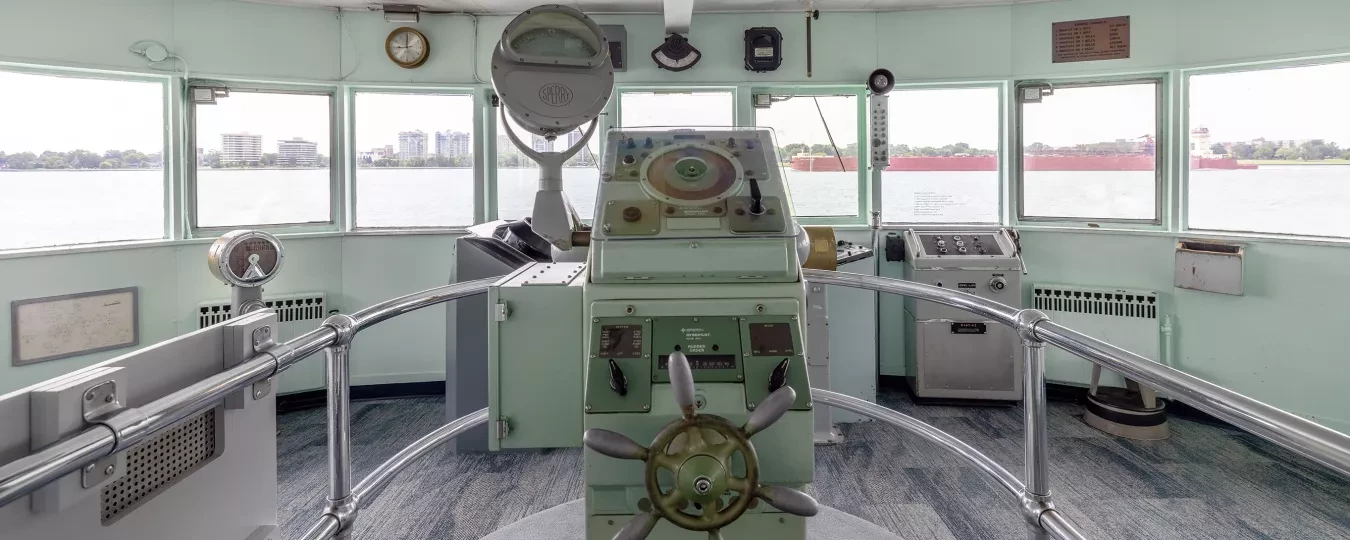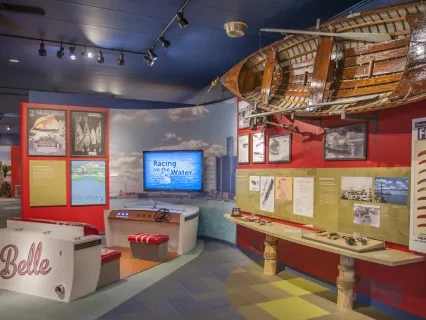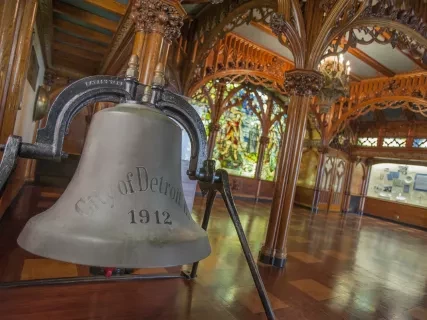
William Clay Ford Pilot House
Walk in the captain’s footsteps on the bridge of Great Lakes freighter S.S. William Clay Ford.
Permanent Exhibits
Dossin Great Lakes Museum
100 Strand Drive, Belle Isle
Detroit, MI 48207
313-821-2661
(Phone)
313-385-4562
(Text for virtual assistance)
Friday - Saturday
10am - 5pm
Sunday
1pm - 5pm
Sunday, December 21, 2025
Free admission
Monday, December 29, 2025 - Tuesday, December 30, 2025
10am - 5pm
Open - Holiday Week
About this Exhibit
The Great Lakes freighter S.S. William Clay Ford provided years of reliable service transporting iron ore and coal from the upper Great Lakes to the River Rouge Steel Plant, a subsidiary of Ford Motor Company. After freighter technology and design advanced, it became obsolete and the ship was scrapped in 1987. Its pilot house was preserved and brought to the Dossin Great Lakes Museum shortly after.
Shipping on the Great Lakes had become increasingly important to the port of Detroit as the city grew. Because of the poor quality of early roads and US highways in Michigan, water travel represented the most practical and economic mode of travel. Sailing ships built to maximum size for travel through a canal, lock or specific water depth traveled through the Great Lakes. Their schedules were unpredictable because they were depended on wind for propulsion. In the 1830s, steam powered ships made lake travel more flexible and reliable. The introduction of iron allowed shipbuilders to design and build larger, more durable hulls.
Built in 1953 at the Great Lakes Engineering Works in River Rouge, Michigan, the S.S. William Clay Ford was a 647-foot straight-decked vessel. It was outfitted with oil-fired boilers that powered a large steam turbine and could make a round trip in just over 5 days - an improvement over the 6-7 day passages by older vessels - and traveled at about 16 mph.
The S.S. William Clay Ford was lengthened to 767 feet in 1979. Despite this change, the vessel still could not compete in the transportation industry because freighter size and technology kept advancing. Over time, ships got bigger and faster, and self-unloading technology allowed owners to increase profits.
When the S.S. William Clay Ford docked at a port, it needed the help of the crew on the dock to unload its cargo. Rouge Steel replaced it with two self-unloading vessels that had the capacity to unload their cargo through a series of shipboard belts and booms at any lake port. The S.S. William Clay Ford was retired in 1987 and was taken apart, its metal recycled, and a portion – the pilot house – donated to the museum.
During a gale-force storm on November 10, 1975, the S.S. William Clay Ford left the safe harbor of Whitefish Point under the command of Captain Donald Erickson in search of survivors from the doomed S.S. Edmund Fitzgerald. All hands aboard the S.S. Edmund Fitzgerald were lost that day, but the S.S. William Clay Ford’s crews' bravery received much recognition.
The lower level of the pilot house shares the S.S. Edmund Fitzgerald story, and the role that the S.S. William Clay Ford played in its rescue attempt. The lower level also provides visitors with information on the design and purpose of freighters. Visitors can try to dock the S.S. William Clay Ford in a port with a video simulator.
At the exit of the pilot house, a periscope that came from the submarine U.S.S. Tambor allows visitors to see the Detroit River and current passing vessels.
The U.S.S. Tambor proved instrumental in the U.S. Navy’s success at the Battle of Midway. This battle represented an important victory because it changed the tide of the war against Japan during World War II, giving the US control over a series of islands that allowed it to bomb the main islands of Japan. The bombing included the two atomic bombs which led to Japan’s surrender. The U.S.S. Tambor sunk many ships on its tour of duty during World War II.


